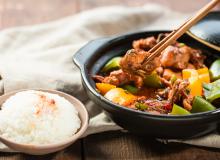Postprandial blood sugar is one of the important indicators of self-management for diabetic patients. So, how should diabetics manage postprandial blood sugar?
If you eat incorrectly, your blood sugar will easily spike after a meal.
Postprandial blood sugar refers to blood sugar two hours after a meal, that is, blood sugar two hours after eating the first bite of food. To determine whether post-meal blood sugar is too high, it should be analyzed in conjunction with pre-meal blood sugar levels.
The root cause of excessive postprandial blood sugar is a decline in pancreatic islet function, including a reduction in the amount of insulin secreted, or a disordered secretion rhythm (slow secretion). On this basis, coupled with the incorrect dietary structure or method of diabetic patients, it ultimately leads to a spike in blood sugar after meals. Eating too many or too refined carbohydrates will cause them to be digested and absorbed quickly. If insulin is not secreted enough or not fast enough, postprandial hyperglycemia will occur. In addition to the single staple food, the intake time of fruits is not appropriate and the meal is fast,” said an expert from Diabetes Companions.
Adjusting your diet can lower postprandial blood sugar
High blood sugar after a meal is not conducive to the stability of blood sugar. So, how should people with diabetes manage high blood sugar after a meal?
Change your diet. Food should not be too refined, it is best to be rich in crude fiber, that is, natural food that has not been refined, such as whole grains, brown rice, black rice, etc.
Slow down your eating speed. The speed of food absorption is related to the speed of eating, so eat slowly. In addition, the food should not be too single. You can eat mixed meals to deal with the shortcoming of insufficient insulin secretion after meals.
Reduce processed foods. Foods that have been cooked many times, such as rice, porridge, noodles, etc., are absorbed faster after being eaten than those that are only processed once. In addition, foods containing a lot of water, such as gruel and rotten rice, are digested faster than hard rice. Therefore, when people with diabetes cook food, it is best not to cook it for too long, not to overcook the food, and drink less gruel.
Adjust exercise to help stabilize blood sugar after meals
In terms of exercise, it is recommended that people with diabetes exercise about half an hour to an hour after a meal. They can use muscle exercise to burn calories and lower postprandial blood sugar. It is recommended to focus on aerobic exercise, and you can choose jogging, brisk walking, dancing, etc. Each exercise lasts about 30 minutes.
In view of the dietary situation of most people with diabetes in my country, to improve the problem of postprandial hyperglycemia, we must first change our eating habits, and then exercise as a supplement. Patients with large blood sugar fluctuations can use drugs under the guidance of a doctor.

